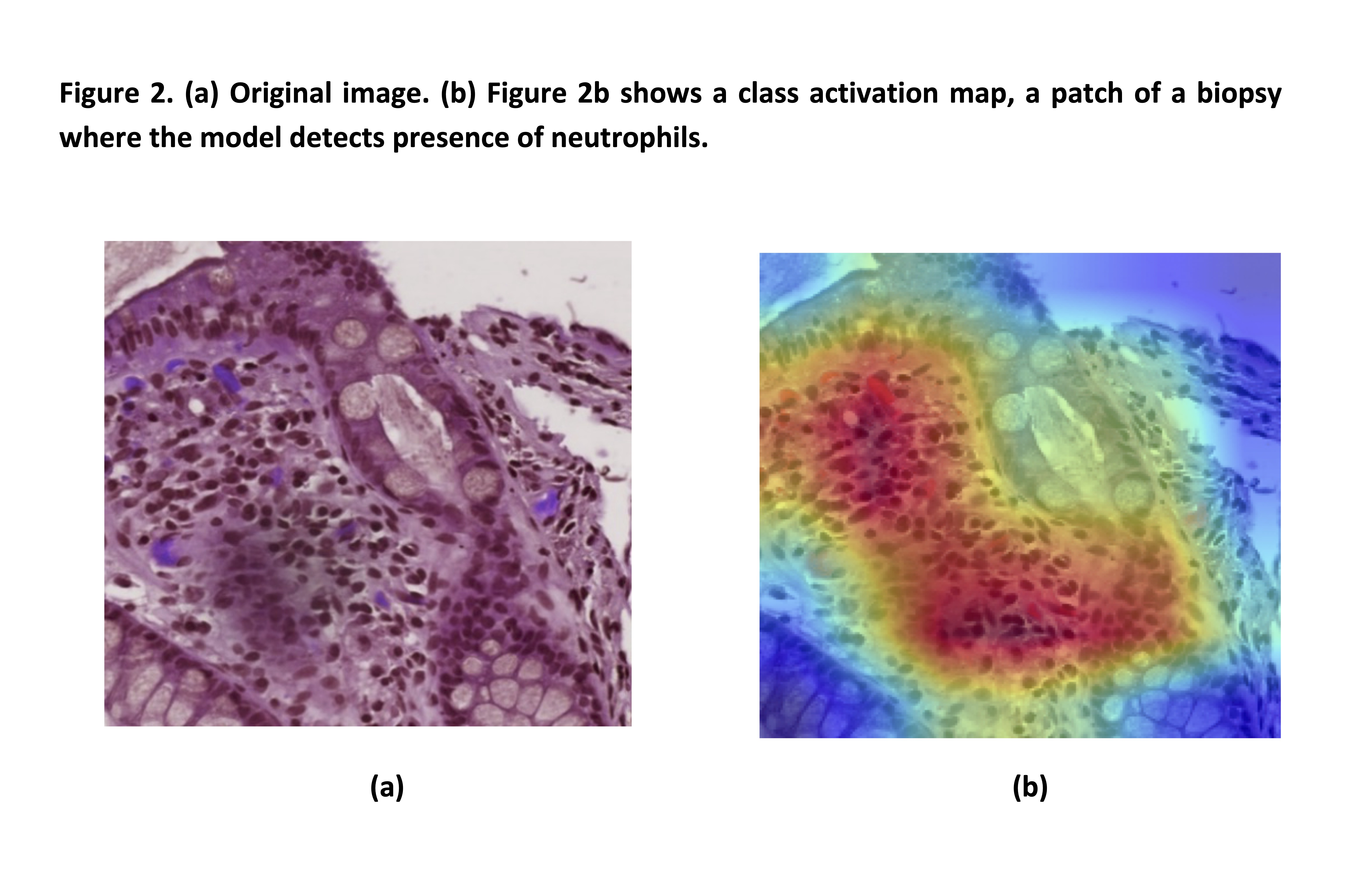OP15 A new simplified histology artificial intelligence system for accurate assessment of remission in Ulcerative Colitis
Villanacci, V.(1);Parigi, T.L.(2,3);Del Amor, R.(4);Mesguer Esbrì, P.(4);Gui, X.(5);Bazarova, A.(6);Bhandari, P.(7);Bisschops, R.(8);Danese, S.(9);De Hertogh, G.(8);Ferraz, J.G.(10);Götz, M.(11);Grisan, E.(12);Hayee, B.(13);Kiesslich, R.(14);Lazarev, M.(15);Mandelli, G.(1);Monica, M.A.T.(1);Panaccione, R.(10);Parra-Blanco, A.(16);Pastorelli, L.(17);Rath, T.(18);Røyset, E.S.(19);Shivaji, U.(3);Tontini, G.E.(17);Vieth, M.(20);Zardo, D.(21);Ghosh, S.(22);Naranjo, V.(4);Iacucci, M.(3);
(1)ASST Spedali Civili- University of Brescia, Institute of Pathology, Brescia, Italy;(2)Humanitas Research Hospital, Department of Biomedical Sciences, Milano, Italy;(3)University of Birmingham, Immunology and Immunotherapy, Birmingham, United Kingdom;(4)Universitat Politécnica de Valéncia, Instituto de Investigación e Innovación en Bioingeniería- I3B, Valencia, Spain;(5)University of Washington School of Medicine, Department of Laboratory Medicine and Pathology, Seattle, United States;(6)University of Cologne, Institute for Biological Physics, Cologne, Germany;(7)Queen Alexandra Hospital, Department of Gastroenterology, Portsmouth, United Kingdom;(8)University Hospitals Leuven, Department of Gastroenterology, Leuven, Belgium;(9)IRCCS Ospedale San Raffaele, Gastroenterology and Endoscopy, Milan, Italy;(10)University of Calgary Cumming School of Medicine, Division of Gastroenterology and Hepatology, Calgary, Canada;(11)Klinikum Böblingen, Division of Gastroenterology, Böblingen, Germany;(12)London South Bank University, School of Engineering, London, United Kingdom;(13)King’s College Hospital, King’s Health Partners Institute of Therapeutic Endoscopy, London, United Kingdom;(14)Helios HSK Wiesbaden, Department of Gastroenterology, Wiesbaden, Germany;(15)Johns Hopkins Hospital, Division of Gastroenterology and Hepatology, Baltimore, United States;(16)University of Nottingham, Department of Gastroenterology, Nottingham, United Kingdom;(17)University of Milan, Department of Pathophysiology and Transplantation, Milan, Italy;(18)University of Erlangen, Department of Gastroenterology, Nuremberg, Germany;(19)Norwegian University of Science and Technology, Department of Clinical and Molecular Medicine, Trondheim, Norway;(20)Friedrich-Alexander University, Institute of Pathology- Klinikum Bayreuth-, Nuremberg, Germany;(21)University Hospitals Birmingham NHS Trust, Department of Cellular Pathology, Birmingham, United Kingdom;(22)University College Cork, Department of Medicine, Cork, Ireland;
Background
Background
Histological remission (HR) is evolving as a treatment target in ulcerative colitis (UC). Several histological indices have been developed, however, their widespread adoption beyond clinical trials is limited by practical difficulties and interobserver variability. Furthermore, the relative complexity of available scores hinders the development of an AI algorithm. We aimed to develop a simple histologic index, aligned to endoscopy, and apply it to a computer-aided diagnosis (CAD) system to evaluate HR.
Methods
Methods
614 digitalised biopsies (WSI) from 307 UC patients enrolled into a prospective multicentre study1 were analysed. First, the simple PICASSO Histologic Remission Index (PHRI) based only on the presence of neutrophils, was developed and validated by expert pathologists. Table 1
To implement PHRI in a CAD system we designed a semi-supervised inductive transfer learning strategy composed of two modules. The first consists of a novel deep learning strategy based on a convolutional neural network architecture. This detected neutrophils in areas (patches) of a subset of 314 biopsies (172 remission, 142 active), in 158 of which the presence of neutrophils had been meticulously annotated at pixel level. WSI were then divided in training (172), validation (47), and testing sets (95).
Following a multiple instance learning paradigm, a second model combined the features of all patches of each biopsy into a dichotomous result: presence/absence of disease activity. Figure 1 and 2. Finally, we compared the AI prediction with the pathologists’ assessment.


Results
Results
PHRI correlated strongly with all endoscopic scores (MES, UCEIS and PICaSSO) of the same bowel areas (rectum and sigmoid) (Spearman’s ρ= 0.55 to 0.78). Inter-reader agreement between pathologists was almost perfect (ICC 0.84).
In the validation and testing sets our model predicted the presence of neutrophils respectively with 61% and 72% sensitivity, 98% and 84% specificity, 93% and 75% positive predictive value (PPV), and 86% and 83% negative predictive value (NPV) respectively (Table 2).
When predicting remission in whole biopsies, in the validation cohort the AI system had 65% sensitivity, 93% specificity, 86% PPV, and 78% NPV. In the testing cohort the same metrics were 62%, 94%, 90%, and 73% (Table 2).
Conclusion
Conclusions
PHRI is the simplest histological index in UC and correlates strongly with endoscopic activity. Based on PHRI we developed the first artificial intelligence model able to accurately predict histological remission in biopsies of UC. This tool can effectively expedite, support, and standardise the histological assessment of UC in clinical practice.
Reference:
1. Iacucci et al. Gastroenterology 2021


